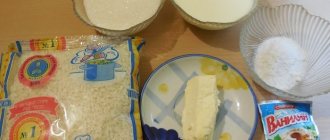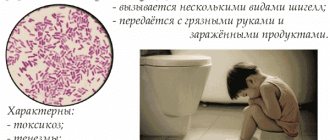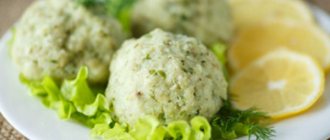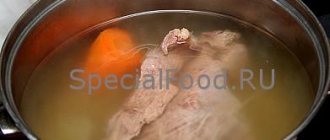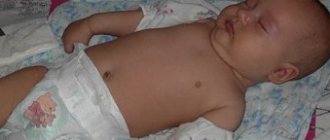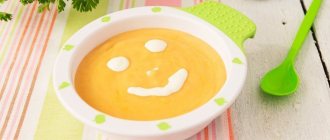Rules and terms for introducing corn porridge into the infant's menu
There are generally accepted rules for starting complementary feeding, developed by health organizations, but for each baby everything is individual. The age recommended by pediatricians for introducing corn porridge is 7-8 months, but provided that the newborn has already mastered some vegetables, rice and buckwheat. There are exceptions. If the newborn’s stomach does not accept other cereals or the baby is not gaining weight well, then the pediatrician may allow you to start consuming liquid corn porridge when breastfeeding at six months, and when bottle-fed at five months.
When trying to introduce a new dish, a nursing mother should not forget about the beneficial benefits of breastfeeding: the baby should not be abruptly weaned from the breast and transferred to “adult” food; complementary foods should replace the breast gradually.
First, give newborn children 1⁄2-1 teaspoon of porridge to try and observe for a couple of days how the baby’s body reacts to the innovation in his diet. If everything is fine, we continue to feed the baby.
We gradually make larger portions, bringing the amount to 150 grams by 8-9 months, and up to two hundred grams by one year.
Since corn porridge takes a long time to digest, infants should consume it 2-3 times a week, but not more often
If there is a change in stool (constipation or weakness), an allergy to corn porridge (for example, redness of the skin, rash, itching), the child becomes restless and capricious, the tummy is swollen, then the new dish should be temporarily excluded. You can give it to your child again no earlier than after 5-6 months.
What is the benefit?
Corn porridge, among other complementary food porridges for babies, is considered the lowest in calories. However, if the mother made sure that this dish for her baby was cooked correctly and did not lose its invaluable beneficial properties for the child’s health during the cooking process, then it will definitely benefit the growing and developing body.
Additionally > How to start feeding a baby at 6 months?
The invaluable benefits are as follows:
- improves digestion due to the content of fiber, which normalizes intestinal functions;
- helps normalize stool, especially in children prone to constipation;
- inhibits fermentation processes in the intestines;
- helps strengthen the immune system;
- promotes the removal of excess fat from the body;
- helps normalize the functioning of the heart and blood vessels;
- strengthens tooth enamel due to the silicon content in its composition.
Reading...
We begin introducing complementary foods to an infant at 5 months.
In addition, children who have become familiar with the problem of allergies or have a hereditary predisposition to it and cannot obtain the necessary minerals and vitamins from many allergenic foods can safely meet their needs with corn porridge.
Composition of the product
The value of ordinary corn porridge is due to its unusual composition. Corn is famous for retaining the entire complex of vitamins and all useful substances after cooking. What makes this product irreplaceable is its huge carbohydrate content, the presence of easily digestible proteins and dietary fiber. Cereals are rich in many vitamins: A, B9, B1, B2, B5, B6, B7, H, biotin, PP, E, as well as minerals: potassium and calcium, phosphorus and magnesium, sulfur and boron, copper, molybdenum, cobalt, sodium , chrome
All these micro- and macroelements take an active part in the formation of immunity and are important for the normal functioning of internal organs, proper metabolism, good growth and development of the child.
Benefits and harms
Corn porridge for babies is a necessary link in the menu and has many advantages:
We recommend reading: Dishes for children under one year old
- it does not contain the protein gluten, which causes allergies in some babies;
- porridge is very low in calories, so it is well absorbed by the child’s digestive system;
- has a good effect on the immune system, has an effective effect after the use of antibiotics, stimulates the body’s defense reactions;
- cleanses and strengthens the circulatory system, helps the heart function; corn also contains acids that remove unnecessary toxins from the body;
- due to the presence of glutamic acid in corn porridge, the child calms down, so it is recommended to prepare it for hyperactive children and during teething;
- normalizes stool, especially when the baby is constipated;
- gives health to hair and skin;
- improves mood.
But parents need to take into account that there are negative aspects if you use corn dishes in large quantities and very often:
- phosphorus in porridge interferes with the absorption of calcium, which is undesirable for the child’s developing skeletal system and growing teeth;
- a violation of the water-salt and acid-base balance is possible, so this dish should be removed from the diet of children with problems with the duodenum and stomach;
- If you have fiber intolerance, your baby may experience stomach and intestinal upset, abdominal pain, bloating, colic, and nausea. Then this porridge must be excluded from the baby’s diet.
Now you know the benefits and harms of corn porridge, and you can determine how important it is for your child.
Why is corn porridge healthy?
In the first year of life, the baby grows very intensively, while simultaneously learning new skills and abilities. If up to six months breast milk or an adapted infant formula completely saturated the baby’s body with vitamins and nutrients, then after six months this is no longer enough, so doctors recommend introducing complementary foods. Which product will be first is decided only by a specialist, depending on the health and weight of the baby.
For children who are gaining weight well, it is recommended to start complementary feeding with vegetable purees at six months, and introduce porridge from seven months. But kids who cannot boast of curvy figures and are slightly behind in terms of average body weight are the first to try porridge.
Doctors often recommend starting complementary feeding with corn porridge.
On the recommendation of pediatricians and gastroenterologists, many parents introduce corn porridge to infants in their first year of life, the benefits of which are as follows:
- does not contain gluten, therefore it is considered a hypoallergenic product;
- is well absorbed in the child’s stomach;
- a balanced composition of vitamins and microelements contributes to the normal development of children;
- helps regulate the functioning of the digestive system, but at the same time it contains a lot of starch, so it strengthens. According to mothers, the dish has different effects on the baby’s stool;
- has a positive effect on the immune system: stimulates the body's defenses. Useful during the recovery period after illness and taking antibiotics;
- has a calming effect, because the composition contains glutamic acid, which stimulates metabolic processes in the central nervous system;
- protects blood vessels from the formation of blood clots, cleanses the blood, thereby having a beneficial effect on the functioning of the heart. These properties are due to the presence of unsaturated fatty acids in corn, which remove cholesterol and other waste from the body.
Corn grits do not lose their beneficial properties when exposed to high temperatures. It can be steamed, boiled or stewed. The result is a tasty dish with a large supply of substances necessary for the body.
But parents should know that in addition to the beneficial properties, corn grits also have negative aspects if consumed every day in large quantities:
- it is possible to increase the phosphorus content in the body and decrease calcium, which will harm the skeletal system and teeth;
- have a negative effect on the acid balance, so they are contraindicated for children who are registered with a gastroenterologist with problems of the gastrointestinal tract and duodenum.
Recommendations for selection and storage
Corn porridge can be not only beneficial, but also harmful if the product is of low quality. Therefore, special attention should be paid to the purchase of corn grits. The following types of cereals are distinguished:
- coarse: the kernels are separated and crushed, but not polished; coarsely ground porridge is better, as it is richer in various vitamins;
- polished: the core is crushed into pieces, its edges are polished;
- fine: crushed grains are also crushed. Used in the production of sweet products, such as corn sticks.

To prepare porridge, you can also buy ready-made corn flour, but it is still recommended to purchase whole grains and grind them yourself
When purchasing a product, you need to pay attention to the following points:
- the packaging must not be damaged; it must indicate the expiration date, name and address of the manufacturer;
- check the grain for cleanliness so that there is no debris or midges in it;
- the cereal should be crumbly, without stray lumps;
- inspect the color: if the corn grits have a bright yellow tint, then everything is in order.
Currently, instant corn porridge in baby food boxes is in demand. A dispute arises here: many mothers are sure that children need to cook on their own, while others prefer boxed cereals, emphasizing that they are healthy, enriched with vitamins and safe (baby food is checked especially carefully), they are also convenient to store, very quick and easy to prepare: Such porridges do not require cooking; simply pour boiling water or hot milk over them, bring to the desired thickness and mix thoroughly to eliminate lumps. To taste, the porridge can be salted, sweetened or chopped fruit can be added.
Important! If the cereal has spoiled, it must be thrown away immediately - not only infants, but also adults cannot cook porridge from missing cereal!
Storing corn grits in your home also plays an important role. It is very difficult to achieve the necessary storage conditions (humidity - 70% and temperature from -5 to +5 degrees Celsius), so there is no need to purchase a lot of cereal for a long time. The product is kept in a sealed glass jar to avoid rancidity, mold and insects.
How to properly prepare corn porridge for babies
If porridge is cooked for newborn children up to one year old, then the cereal must first be sorted, washed, dried, and then crushed to flour. During cooking, the grain becomes four times larger, so we also pour four times more water (that is, take 2 cups of water per 0.5 cup of crushed grain) and wait until it boils. Add the cereal to boiling water (milk) to preserve all the nutrients, cook for 10-15 minutes, stirring constantly to avoid burning. Let it brew for at least 20 minutes. Porridge made from corn flour turns out to be very soft and tender, without lumps, it is easy for a child to eat.
It is recommended to store the finished porridge in the refrigerator, but not more than 24 hours.
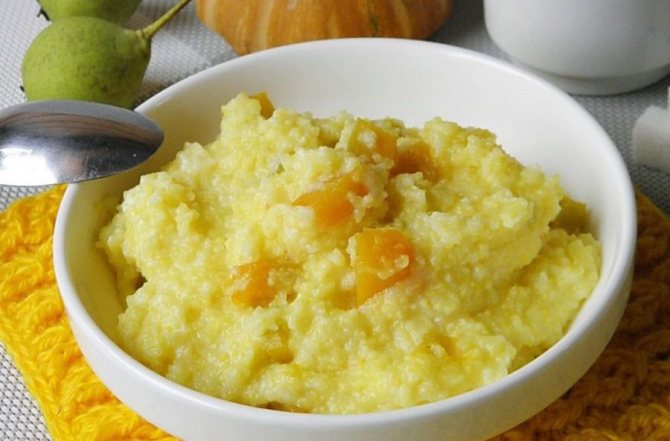
It is advisable to heat it in a water bath, but it is best to cook fresh porridge before each feeding
You can use another recipe for preparation when it is not possible to grind the product. In this case, you need to cook the corn porridge for 35-40 minutes, and then you also need to let it sit under the lid. After which the finished mixture is pureed in a blender.
It turns out incredibly tasty in the oven. To do this, we use a clay pot, pour water, add cereal, salt and put it in the oven, heated to 180 degrees. After 20-25 minutes, stir the porridge, and after 50-60 minutes, remove the pot from the oven.
Knowing how to cook corn porridge for babies in a double boiler and slow cooker, you can get a crumbly dish with a wonderful taste and aroma. Here you will need water and crushed cereals (flour). We cook using the “rice” mode, pour the cereal into the water in a ratio of 1:3. We also add salt, a little butter and sugar.

It is undoubtedly recommended to prepare such porridge with water or milk, but if the baby is not yet ready for dairy products, you can also use breast milk. Mom decides how to cook it
What is corn porridge valued for?
Dishes made from corn grits are popular among many peoples of the world. And the porridge made from it is recognized as the “queen of the table.” Among its varieties are Italian polenta, the Cossack national mamalyga with milk, temalis from Mexican cuisine with coconut, meat or raisins.
Here in Russia, we love corn porridge because it is inexpensive, versatile, tasty and quick to prepare. Nutritionists recommend including this unique product in the diet of children, the elderly, pregnant women, especially in the first trimester, to relieve the unpleasant sensations of toxicosis, and for those who want to lose weight.
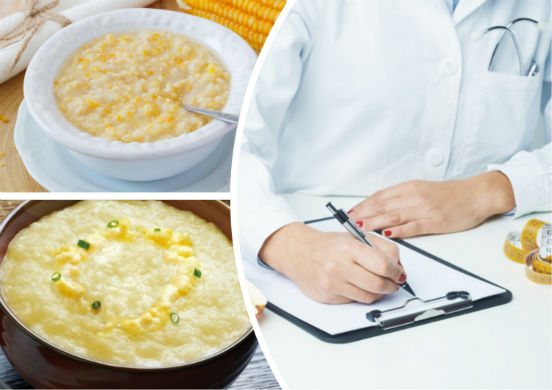
In addition, its constant use promotes in the human body:
- Removal of waste, toxins, fats, pesticides, radionuclides;
- Prevention of neurological diseases, diabetes, hypertension, anemia;
- Regulating cholesterol levels;
- Normalization of digestive functions, blood microcirculation and lipid metabolism;
- Improving skin condition;
- Strengthening the cardiovascular and nervous systems;
- Reducing bloating and other symptoms of flatulence;
- Increased performance;
- Losing excess weight;
- Restoring vitality;
- Preventing fermentation processes in the intestines;
- Slowing down the aging process;
- Reducing the risk of developing cancer.
At the same time, I want to focus your attention on the fact that corn grits during the cooking process retain all of its healing and beneficial characteristics of natural grain.
How to diversify a dish
When cooking corn porridge for babies, you can get a little creative. There are a lot of interesting recipes used. We offer you some of them:
- With various vegetables. We will need vegetables suitable for initial feeding. This could be broccoli, cauliflower, carrots, onions, pumpkin, zucchini. Cook chopped onions, pumpkin and other vegetables separately. Add the cereal to the broth prepared with vegetables. Cook over low heat for 30 minutes. Then leave for another 20 minutes, adding cooked vegetables. Grind everything into a homogeneous mass. This corn porridge turns out to be very filling and extremely tasty.
- With meat. Meat products begin to be used in feeding from 8-9 months, and by 10-11 months a mixture of vegetables, meat and various cereals is already allowed. To prepare delicious corn porridge with meat, you first need to boil several pieces of meat fillet. You can use rabbit, veal, young chicken. Corn porridge is cooked in meat broth, which after infusion must be combined with meat and pureed in a blender. When cooking meat, you can add vegetables to the water - onions, carrots, zucchini, which will add vitamins to the dish.
- With various fruits. Prepare the cereal according to the above recipes. It is better to cook corn porridge from corn flour. Then mix with your baby's favorite fruit. You can take apples, pears, bananas, dried apricots, raisins, which are peeled, grated or simply kneaded. This makes an interesting sweet dish.
Taking care of children is the main goal and task of any parent. Therefore, it is imperative to cook corn porridge for babies. The benefits of corn grits are extremely great.
